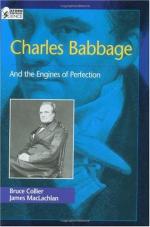|
This section contains 916 words (approx. 4 pages at 300 words per page) |

|
Although the abacus, the first tool of calculation, has existed since ancient times, advanced calculating machines did not appear until the early 1600s. Scientists and mathematicians were determined to simplify complex astronomical and navigational calculations and realized that mechanical machines were the means to achieve this. In 1617 John Napier (1550-1617), a Scottish mathematician, originated the concept of logarithms. By using logarithms, multiplication and division could be performed by repeated addition and subtraction. Napier mechanized the calculating process by placing his logarithms on wooden cylinders, the surface of which contained numbers that could be manipulated to perform the accurate calculation. the cylinders, enventually made of bone or ivory, came to be known as Napier's bones. For years following its invention, other mathematicians used Napier's bones as the basis for their calculating devices. In 1623 German mathematician Wilhelm Schickard etched the logarithms on cylinders turned by a dial, so...
|
This section contains 916 words (approx. 4 pages at 300 words per page) |

|


